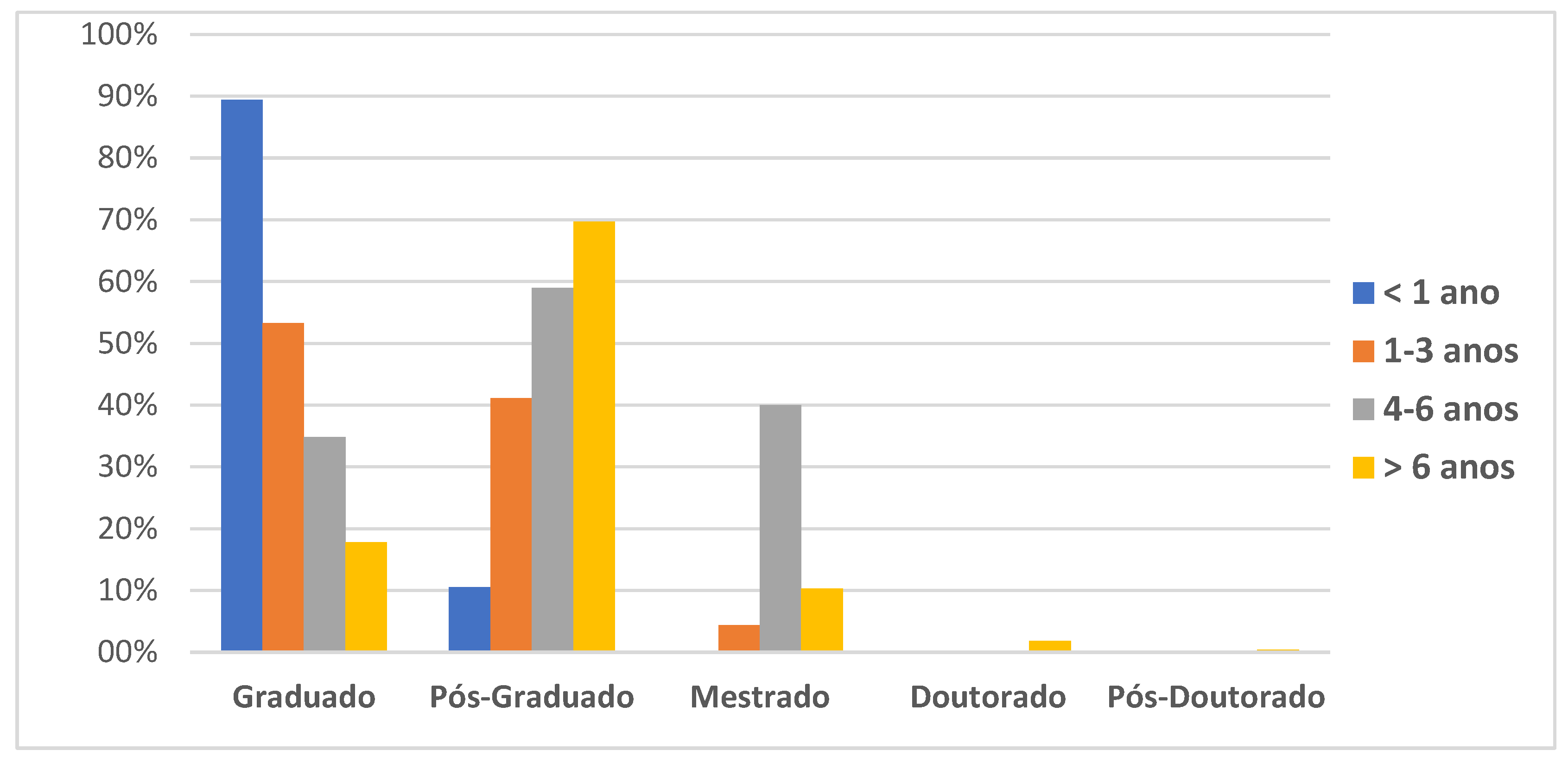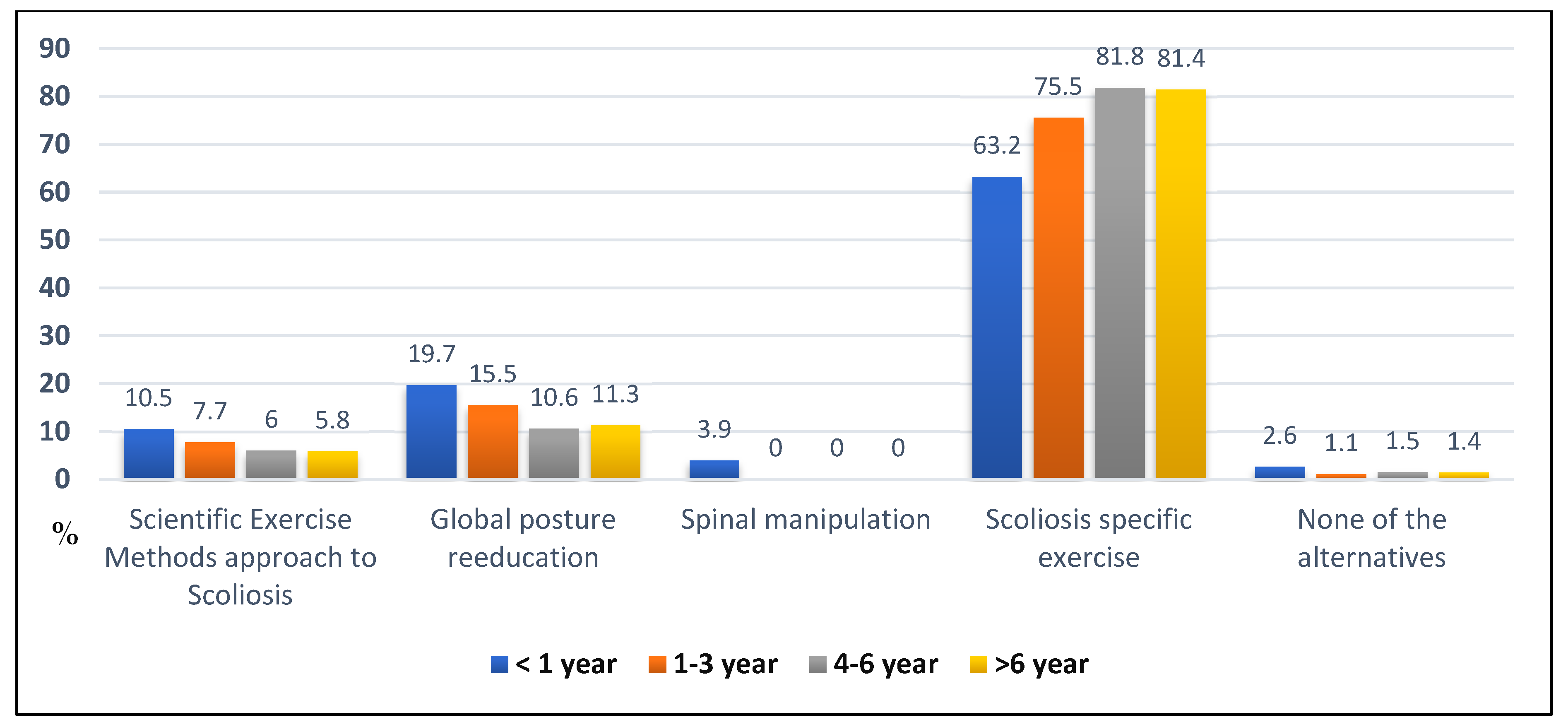The Impact of Training Time on Understanding the Treatment of Adolescent Idiopathic Scoliosis According to SOSORT International Guidelines: An Online Survey Study
Abstract
1. Introduction
2. Methods
3. Data Collection
4. Statistical Analysis
5. Results
Participants
6. Discussion
7. Conclusions
Supplementary Materials
Author Contributions
Funding
Institutional Review Board Statement
Informed Consent Statement
Data Availability Statement
Conflicts of Interest
References
- Negrini, S.; Donzelli, S.; Aulisa, A.G.; Czaprowski, D.; Schreiber, S.; de Mauroy, J.C.; Diers, H.; Grivas, T.B.; Knott, P.; Kotwicki, T.; et al. 2016 SOSORT Guidelines: Orthopaedic and Rehabilitation Treatment of Idiopathic Scoliosis during Growth. Scoliosis Spinal Disord. 2018, 13, 3. [Google Scholar] [CrossRef] [PubMed]
- Cheng, J.C.; Castelein, R.M.; Chu, W.C.; Danielsson, A.J.; Dobbs, M.B.; Grivas, T.B.; Gurnett, C.A.; Luk, K.D.; Moreau, A.; Newton, P.O.; et al. Adolescent Idiopathic Scoliosis. Nat. Rev. Dis. Prim. 2015, 1, 15030. [Google Scholar] [CrossRef] [PubMed]
- Fan, Y.; Ren, Q.; To, M.K.T.; Cheung, J.P.Y. Effectiveness of Scoliosis-Specific Exercises for Alleviating Adolescent Idiopathic Scoliosis: A Systematic Review. BMC Musculoskelet. Disord. 2020, 21, 495. [Google Scholar] [CrossRef] [PubMed]
- Penha, P.J.; Ramos, N.L.J.P.; De Carvalho, B.K.G.; Andrade, R.M.; Schmitt, A.C.B.; João, S.M.A. Prevalence of Adolescent Idiopathic Scoliosis in the State of São Paulo, Brazil. Spine 2018, 43, 1710–1718. [Google Scholar] [CrossRef] [PubMed]
- Cheung, K.M.C.; Wang, T.; Qiu, G.X.; Luk, K.D.K. Recent Advances in the Aetiology of Adolescent Idiopathic Scoliosis. Int. Orthop. 2008, 32, 729. [Google Scholar] [CrossRef]
- Zhou, Z.; Liu, F.; Li, R.; Chen, X. The Effects of Exercise Therapy on Adolescent Idiopathic Scoliosis: An Overview of Systematic Reviews and Meta-Analyses. Complement. Ther. Med. 2021, 58, 102697. [Google Scholar] [CrossRef]
- REAMY, B.V.; SLAKEY, J.B. Adolescent Idiopathic Scoliosis: Review and Current Concepts. Am. Fam. Physician 2001, 64, 111–117. [Google Scholar] [PubMed]
- Black, D.A.J.; Pilcher, C.; Drake, S.; Maude, E.; Glynn, D. Current Knowledge of Scoliosis in Physiotherapy Students Trained in the United Kingdom. Scoliosis Spinal Disord. 2017, 12, 34. [Google Scholar] [CrossRef] [PubMed]
- Ciazynski, D.; Czernicki, K.; Durmala, J. Knowledge about Idiopathic Scoliosis among Students of Physiotherapy. Stud. Health Technol. Inform. 2008, 140, 281–285. [Google Scholar] [CrossRef] [PubMed]
- De Souza, F.S.; Ladeira, C.E.; Costa, L.O.P. Adherence to Back Pain Clinical Practice Guidelines by Brazilian Physical Therapists. Spine 2017, 42, E1251–E1258. [Google Scholar] [CrossRef] [PubMed]
- Peterson, S.; Shepherd, M.; Farrell, J.; Rhon, D.I. The Blind Men, the Elephant, and the Continuing Education Course: Why Higher Standards Are Needed in Physical Therapist Professional Development. J. Orthop. Sport. Phys. Ther. 2022, 52, 642–646. [Google Scholar] [CrossRef] [PubMed]
- Barton, C.J.; King, M.G.; Dascombe, B.; Taylor, N.F.; de Oliveira Silva, D.; Holden, S.; Goff, A.J.; Takarangi, K.; Shields, N. Many Physiotherapists Lack Preparedness to Prescribe Physical Activity and Exercise to People with Musculoskeletal Pain: A Multi-National Survey. Phys. Ther. Sport 2021, 49, 98–105. [Google Scholar] [CrossRef] [PubMed]
- Zavarize, S.F.; Wechsler, S.M. Evaluación de las diferencias de género en las estrategias de afrontamiento del dolor lumbar. Acta Colomb. Psicol. 2016, 19, 46–56. [Google Scholar] [CrossRef]
- Conselho Nacional de Educação Câmara de Educação Superior Resolução cne/ces 4, de 19 de Fevereiro de 2002. Available online: http://portal.mec.gov.br/cne/arquivos/pdf/CES042002.pdf (accessed on 28 October 2022).
- Berdishevsky, H.; Lebel, V.A.; Bettany-Saltikov, J.; Rigo, M.; Lebel, A.; Hennes, A.; Romano, M.; Białek, M.; M’hango, A.; Betts, T.; et al. Physiotherapy Scoliosis-Specific Exercises—a Comprehensive Review of Seven Major Schools. Scoliosis Spinal Disord. 2016, 11, 20. [Google Scholar] [CrossRef] [PubMed]
- Burger, M.; Coetzee, W.; du Plessis, L.Z.; Geldenhuys, L.; Joubert, F.; Myburgh, E.; van Rooyen, C.; Vermeulen, N. The Effectiveness of Schroth Exercises in Adolescents with Idiopathic Scoliosis: A Systematic Review and Meta-Analysis. S. Afr. J. Physiother. 2019, 75, 1–9. [Google Scholar] [CrossRef] [PubMed]
- Thompson, J.Y.; Williamson, E.M.; Williams, M.A.; Heine, P.J.; Lamb, S.E. Effectiveness of Scoliosis-Specific Exercises for Adolescent Idiopathic Scoliosis Compared with Other Non-Surgical Interventions: A Systematic Review and Meta-Analysis. Physiotherapy 2019, 105, 214–234. [Google Scholar] [CrossRef] [PubMed]
- Yagci, G.; Yakut, Y. Core Stabilization Exercises versus Scoliosis-Specific Exercises in Moderate Idiopathic Scoliosis Treatment. Prosthet. Orthot. Int. 2019, 43, 301–308. [Google Scholar] [CrossRef] [PubMed]
- Vergari, C.; Skalli, W.; Abelin-Genevois, K.; Bernard, J.C.; Hu, Z.; Cheng, J.C.Y.; Chu, W.C.W.; Assi, A.; Karam, M.; Ghanem, I.; et al. Effect of Curve Location on the Severity Index for Adolescent Idiopathic Scoliosis: A Longitudinal Cohort Study. Eur. Radiol. 2021, 31, 8488–8497. [Google Scholar] [CrossRef] [PubMed]



| Experience Time | Public | Private | ||
|---|---|---|---|---|
| Yes (%) | Yes (%) | |||
| Less than 1 year | 13 (17.1) | 63 (82.8) | ||
| Between 1 and 3 years | 23 (25.5) | 67 (74.4) | ||
| Between 4 and 6 years | 18 (27.3) | 48 (72.7) | ||
| More than 6 years | 40 (14.6) | 234 (84.4) | ||
| Operating region | <1 year (n = 76) | 1–3 years (n = 90) | 4–6 years (n = 66) | >6 years (n = 274) |
| Yes (%) | Yes (%) | Yes (%) | Yes (%) | |
| North | 13 (17.1) | 08 (8.9) | 07 (10.6) | 11 (4.7) |
| Northeast | 31 (40.7) | 31 (34.4) | 24 (36.4) | 63 (27.0) |
| Midwest | 09 (11.8) | 09 (10.0) | 05 (7.6) | 22 (9.4) |
| Southeast | 19 (25.0) | 89 (98.8) | 17 (25.7) | 149 (63.6) |
| South | 04 (5.3) | 07 (7.8) | 13 (19.7) | 29 (12.4) |
| Place of Work | <1 year (n = 76) | 1–3 years (n = 90) | 4–6 years (n = 66) | >6 years (n = 274) |
| Yes (%) | Yes (%) | Yes (%) | Yes (%) | |
| Clinic | 25 (32.9) | 45 (50.0) | 48 (72.7) | 273 (99.6) |
| Public servant | 2 (2.6) | 3 (3.3) | 13 (19.6) | 30 (10.9) |
| Home care | 32 (0.0) | 24 (26.6) | 14 (21.2) | 16 (5.8) |
| Gym | 0 (0.0) | 0 (0.0) | 01 (1.5) | 6 (2.2) |
| Hospital | 02 (2.6) | 01 (1.1) | 04 (6.0) | 0 (0.0) |
| Other | 15 (19.7) | 07 (7.7) | 0 (0.0) | 19 (6.7) |
| Number of patients seen | <1 year (n = 76) | 1–3 years (n = 90) | 4–6 years (n = 66) | >6 years (n = 274) |
| Yes (%) | Yes (%) | Yes (%) | Yes (%) | |
| 1 to 5 | 74 (97.3) | 84 (93.3) | 55 (83.3) | 207 (88.5) |
| 5 to 10 | 2 (2.7) | 6 (6.6) | 6 (9.0) | 40 (17.0) |
| >10 | 0 (0.0) | 0 (0.0) | 5 (7.6) | 24 (10.2) |
| Specific treatment technique | <1 year (n = 76) | 1–3 years (n = 90) | 4–6 years (n = 66) | >6 years (n = 274) |
| n (%) | n (%) | n (%) | n (%) | |
| Yes | 23 (30.2) | 31 (34.4) | 45 (68.2) | 194 (83.0) |
| No | 53 (69.8) | 59 (65.6) | 21 (31.8) | 80 (34.2) |
| Technical training | <1 year (n = 76) | 1–3 years (n = 90) | 4–6 years (n = 66) | >6 years (n = 274) |
| Yes (%) | Yes (%) | Yes (%) | Yes (%) | |
| Presential course | 16 (21.0) | 30 (33.3) | 35 (53.0) | 164 (59.8) |
| Online course | 6 (7.8) | 4 (4.4) | 8 (12.1) | 32 (11.6) |
| Symposium | 1 (1.3) | 5 (5.5) | 2 (3.0) | 9 (3.2) |
| Not done | 53 (69.7) | 51 (56.6) | 21 (31.8) | 69 (25.8) |
| Correct Answers n (%) | ||||
|---|---|---|---|---|
| Questions | <1 year (n = 76) | 1–3 years (n = 90) | 4–6 years (n = 66) | >6 years (n = 274) |
| What is AIS *? | 72 (94.74) ** | 86 (95.5) ** | 61 (92.4) | 243 (88.6) |
| What are the causes of AIS? | 0 (0.0) | 5 (5.5) | 1 (1.5) | 8 (2.9) |
| When does AIS develop? | 72 (94.7) ** | 86 (95.5) ** | 61 (92.4) ** | 263 (95.9) ** |
| What is the prevalence of AIS among scoliosis in general? | 11 (14.4) | 7 (7.7) | 8 (12.1) | 27 (9.8) |
| When is the diagnosis confirmed? | 57 (75) | 60 (66.6) | 35 (53.0) | 167 (61.3) |
| What does Risser represent? | 54 (71.0) | 47 (52.2) | 40 (60.6) | 180 (65.6) |
| What is the Adams test? | 7 (9.2) | 11 (12.2) | 5 (7.5) | 40 (14.5) |
| How is the referral to the physical therapist made? | 40 (52.6) | 54 (60.0) | 33 (50.0) | 153 (55.8) |
| When is conservative treatment recommended? | 53 (69.7) | 60 (66.6) | 27 (40.9) | 149 (54.3) |
| What are the goals of conservative treatment? | 70 (92.1) ** | 77 (85.5) | 61 (92.4) ** | 241 (87.9) |
| When is the use of a brace recommended? | 55 (72.3) | 50 (55.5) | 41 (62.1) | 169 (61.6) |
| What are the recommended physical therapy exercises to prevent the progression of AIS? | 76 (100) ** | 86 (95.5) ** | 60 (90.9) ** | 256 (93.4) ** |
| What are the recommendations for patients with AIS who practice physical activity? | 62 (81.5) | 78 (86.6) | 57 (86.3) | 236 (86.1) |
Publisher’s Note: MDPI stays neutral with regard to jurisdictional claims in published maps and institutional affiliations. |
© 2022 by the authors. Licensee MDPI, Basel, Switzerland. This article is an open access article distributed under the terms and conditions of the Creative Commons Attribution (CC BY) license (https://creativecommons.org/licenses/by/4.0/).
Share and Cite
Linhares, N.A.; Barbosa, J.C.; Penha, P.J.; Andrade, R.M.; Ribeiro, A.P.; Magalhães, M.O. The Impact of Training Time on Understanding the Treatment of Adolescent Idiopathic Scoliosis According to SOSORT International Guidelines: An Online Survey Study. Children 2022, 9, 1673. https://doi.org/10.3390/children9111673
Linhares NA, Barbosa JC, Penha PJ, Andrade RM, Ribeiro AP, Magalhães MO. The Impact of Training Time on Understanding the Treatment of Adolescent Idiopathic Scoliosis According to SOSORT International Guidelines: An Online Survey Study. Children. 2022; 9(11):1673. https://doi.org/10.3390/children9111673
Chicago/Turabian StyleLinhares, Natália Albim, Juliene Corrêa Barbosa, Patrícia Jundi Penha, Rodrigo Mantelatto Andrade, Ana Paula Ribeiro, and Mauricio Oliveira Magalhães. 2022. "The Impact of Training Time on Understanding the Treatment of Adolescent Idiopathic Scoliosis According to SOSORT International Guidelines: An Online Survey Study" Children 9, no. 11: 1673. https://doi.org/10.3390/children9111673
APA StyleLinhares, N. A., Barbosa, J. C., Penha, P. J., Andrade, R. M., Ribeiro, A. P., & Magalhães, M. O. (2022). The Impact of Training Time on Understanding the Treatment of Adolescent Idiopathic Scoliosis According to SOSORT International Guidelines: An Online Survey Study. Children, 9(11), 1673. https://doi.org/10.3390/children9111673







